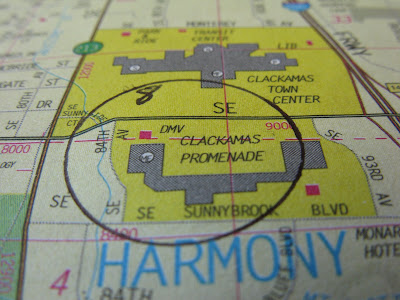Flip 21--Laurelhurst Park and Surroundings
10/30/16 Sunday 10:00 AM
Location: Laurelhurst Park and points east
It's hard to believe that it has been more than five years since touching this project.
Today's flip takes me back to the neighborhood where it began in 2007, Laurelhurst.
In fact, long before even that, I have memories of my parents taking me to feed the ducks on the pond in Laurelhurst Park. It may also be that some of the first photos I ever took were of ducks on that same pond.
The park has an interesting history. According to the city's webpage, the parcel of land on which it sits was purchased in 1909 from the estate of William S. Ladd, one of the city's founding fathers. The spring-fed pond--Firwood Lake--which is one of the park's most famous features, was once a watering trough for cattle and swimming hole for neighborhood residents.
That was before 1912, when Portland Park Superintendent Emanuel Mische designed what we know today as Laurelhurst Park. Before coming to Portland, Mische worked for the famed Olmsted landscape architecture firm, responsible for the design of Central Park as well as the grounds of the U.S. Capitol and White House. In addition to Laurelhurst, Mische can be credited for Ladd's Addition, Mount Tabor Park and other beloved Portland green spaces.
And it is in the park that my friend Lee and I begin our walk.
 |
| Lee |
The day is typical for Portland in the fall. Everything is damp, and the ground is covered in a carpet of oak and maple leaves.
We are not alone in taking photos today, and for good reason. The colors are gorgeous.
 |
| Photo: Lee Perry |
 |
| Photo: Lee Perry |
 |
| Photo: Lee Perry |
A couple asks me to take one of them.
 |
| Photo: Lee Perry |
For a while we watch the ducks on the pond.
 |
| Photo: Lee Perry |
Apparently the ducks don't care about following the rules.
Leaving the park, we head south to Stark Street and turn east, crossing busy César E. Chávez Boulevard, renamed--controversially--from 39th Avenue in 2009.
A block from Chávez we turn down Peacock Lane, site of an annual Christmas lights festival that has been going since the 1940s. My family goes almost every year. It's odd to see this otherwise normal street during the daytime, without holiday lights, and without the yard decorations that are a part of the festival.
Most of the English Cottage-style homes on the block were designed by the same builder, R.F. Wassell, in the 1920s.
I notice a red sign stuck in the lawn of one of the houses. It reads: "SAVE PORTLAND'S TRADITION: STOP DEVELOPMENT ON PEACOCK LANE!" The homeowner is in front of the house, so we introduce ourselves to him, curious about the story behind the sign. The man, sporting an impressive-yet-dignified handlebar mustache, is equally curious about what we're up to.
 |
| Photo: Lee Perry |
His name is Jesse, and he's lived on Peacock Lane for decades. When we ask about the sign, he points across the street at a wide side yard adjacent to a house.
 |
| Source: Google Maps |
Jesse says the property has been subdivided and construction will soon begin on a home to fill the gap between the two existing ones. Additionally, the home on the right is now owned by a homebuilding company, according to portlandmaps.com, so it, too, will likely be torn down and replaced. To prevent similar developments from happening elsewhere on the block, a group of neighbors is engaged in a campaign to get the street named a National Historic District, hence the sign in Jesse's yard.
According to the campaign's GoFundMe.com page, this is what the new house may look like:
 |
| Source: GoFundMe.com |
I have always been curious about what it's like to live on Peacock Lane. I assumed--wrongly--that there was some sort of Home Owners' Association that required that the homes be decorated every Christmas. Jesse explains that the decorations are purely voluntary and that residents participate out of a sense of community and tradition.
Jesse also has a very cool van in his driveway, which he says was hand-painted and sold to him by Escape Campervans.
 |
| Photo: Lee Perry |
It isn't only on Peacock Lane that change is afoot. As we walk around the neighborhood, construction and renovation are present everywhere . . .
. . . as are signs of a hot real estate market.
It's also the day before Halloween. Seeing the Halloween decorations and the political signs together remind me of trick-or-treating in 1988, when Dukakis and George H.W. Bush were battling for the White House. I can't remember what costume I wore that year, but I do remember seeing Dukakis/Bentsen signs while walking that night. There weren't many Bush/Quayle signs in Northeast Portland, even back then.
 |
| Photo: Lee Perry |
Lee finds a bright flower in bloom, despite the late season.
 |
| Photo: Lee Perry |
We notice that several of the Craftsman-style homes in the area have Asian features. Later research shows that most were built around 1916 or 1917, though I can't find anything further on their Asian influence.
 |
| Photo: Lee Perry |
 |
| Photo: Lee Perry |
 |
| Photo: Lee Perry |
 |
| Photo: Lee Perry |
So if there's a theme of today's walk, it is change: changing seasons, changing landscapes, changing politics, changes in the built environment.
For example, I bet the workers who laid this concrete slab . . .
. . . could have never imagined a special turn lane for cyclists to protect them from automobiles.
My thanks to Lee Perry for his deft photography and for accompanying me on this walk, as well as to his wife, Sara Roth, for having flipped the penny onto such an auspicious spot.














Comments